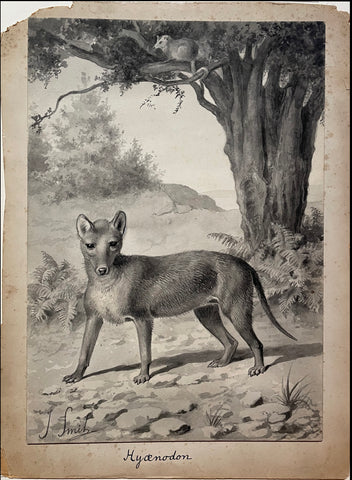
Joseph Smit (1836-1929), Hyaenodon
Joseph Smit (1836-1929)
Hyaenodon
Original Illustration in pen, ink and grey wash, heightened in white.
c. 1905-1912
10 1/2 x 7 1/8 in. sheet
Original artwork for Henry R. Knipe’s Nebula to Man. Illustrated on page 132. Hyaenodon/Remains found in Europe and North America.
Although Hyaenodon translates a “hyena tooth” the only similarities between Hyaenodon and hyenas are the facts that they are both mammals and they both eat meat. Beyond this they are completely different animals with hyenas being more closely related to cats and Hyaenodon actually being a creodont, a long extinct group of mammals that did not survive the Miocene.
Hyaenodon was the top predator of its day with the larger forms dominating the landscapes throughout the Oligocene periods. The Hyaenodon had specially adapted slicing teeth at the back of these jaws. These teeth is that as the animal grew older these slicing teeth would rotate against each other. This constant grinding against each other meant that Hyaenodon maintained a cutting edge across these teeth for much longer than other carnivores and possibly had a longer life expectancy because of it.
JOSEPH SMIT (1836-1929)
Josef Smit’s dinosaur drawings are a high point in his fine draughtsmanship and unique in his vision to construct an image based on a written description rather than a physical specimen. Knipe’s preface indicates that Smit also learned much from Charles Knight’s drawings at the Museum of Natural History, New York.
Josef Smit was born and raised in Lisse, in southern Holland. Later, in Leiden, his scientific fidelity came to the Natural History Museum of Leiden director Hermann Schlegel’s attention. He presented the artist with his first commission to paint a series of birds from the Dutch East Indies. Smit’s work for Schlegel earned him a significant commission to prepare hundreds of plates for Philip Sclater’s Exotic Ornithology. Once in London, the artist met other like-minded artist-naturalists and developed a reputation for preparing very realistic drawings. Because of his ability to delineate every detail of a specific bird, he was employed by several scientists to illustrate their reports and publications. His work stood apart from his contemporaries in his addition of thorough backgrounds of leaves, vines, and tree branches. Smit eventually became a key contributor to some of the most important natural history publications of the 19th and early-20th centuries. His work graced the tomes by John Gould, Edward Lear, Archibald Thorburn, Henry Constantine Richter, and J.G. Keulemans. His son, Pierre-Jacques Smit was also a skilled watercolorist.
ORIGINAL WATERCOLORS PREPARED FOR HENRY KNIPE’S
NEBULA TO MAN (1905) & EVOLUTION IN THE PAST (1911-1912)
An exceedingly rare collection of original watercolors prepared for Henry Knipe’s Nebula to Man (1905) and Evolution in the Past (1911-1912) by naturalist-artists Alice Woodward, Josef Smit, and Charles Whymper.
Drawings prepared for Knipe’s Nebula to Man (1905) contributed to one of the most important publications on dinosaurs on the heels of the Great Dinosaur Rush or Bone Wars. The Bone Wars occurred between 1877 and 1892 between Edward Drinker Cope, the Academy of Natural Sciences Philadelphia, and Othniel Charles Marsh, the Peabody Museum of Natural History at Yale. These early paleontologists fought ruthlessly to pursue dinosaur fossils, a quest that resulted in an extraordinary period of discovery and the eventual financial ruin of both scientists. Their findings resulted in unearthing 136 new dinosaur species, ushering in a new paleontological research era.
According to Henry Knipe’s obituary, he worked for the British Museum. It was there that he likely met the artists tapped for this project. Knipe chose each illustrator for their reputation for scientific authenticity—namely, those skilled as bird artists, given the many similarities between bird species and dinosaurs.
We Also Recommend

![Albertus Seba (1665-1736) Tab I [Insects]](http://aradergalleries.com/cdn/shop/products/I_large.jpg?v=1635434052)
![Albertus Seba (1665-1736) Tab II [Insects]](http://aradergalleries.com/cdn/shop/products/II_large.jpg?v=1635434726)
![Albertus Seba (1665-1736) Tab III [Insects]](http://aradergalleries.com/cdn/shop/products/III_large.jpg?v=1635434877)
![Albertus Seba (1665-1736) Tab L [Insects]](http://aradergalleries.com/cdn/shop/products/L_b_large.jpg?v=1635435506)
![Albertus Seba (1665-1736) Tab L [Insects]](http://aradergalleries.com/cdn/shop/products/L_large.jpg?v=1635437893)